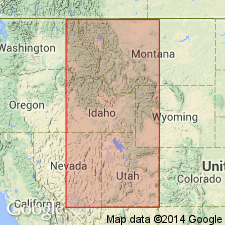
- Usage in publication:
-
- Brush Canyon Member
- Modifications:
-
- Named
- Biostratigraphic dating
- Reference
- Dominant lithology:
-
- Limestone
- Mudstone
- AAPG geologic province:
-
- Great Basin province
- Wasatch uplift
Summary:
Named as middle member (of 3) of newly named Henderson Canyon Formation; named for Brush Canyon in Samaria Mountains, Oneida Co, ID, Great Basin province. Type section (47.3 m thick) is that part of type Henderson Canyon Formation previously referred to as member B and basal member C by Wickwire (1985), and member 2 and basal member 3 [of Lodgepole Limestone] by Beus (1968) in S1/2 sec 12, T16S, [R35W], Oneida Co, ID. Reference section designated [not described] at Leatham Hollow, Cache Co, UT. Occurs in southeastern ID and northeastern UT in Great Basin province and Wasatch uplift. Forms slope, commonly with two or three benches in upper third. Consists of medium to dark-gray wackestones and mudstones which weather light to medium gray, rarely tan or yellow-tan, are thin-bedded, and rarely contain chert nodules. Described as a gray, medium- to coarse-grained limestone by Beus. Is 89.6 m thick at type. Overlies Chinese Wall Member (new) of Henderson Canyon Formation; underlies Devil Creek Member (new) of Henderson Canyon Formation. Fossils are abundant locally which are dominantly crinoidal debris and solitary corals with some gastropods, brachiopods, rare blastoids, and starfish; conodonts are sparse. Correlation chart. Fossil list. Age given as Kinderhookian, Early Mississippian. Lower part is in the UPPER SIPHONODELLA and SIPHONODELLA ISOSTICHA Zones (conodont zones).
Source: GNU records (USGS DDS-6; Denver GNULEX).
For more information, please contact Nancy Stamm, Geologic Names Committee Secretary.
Asterisk (*) indicates published by U.S. Geological Survey authors.
"No current usage" (†) implies that a name has been abandoned or has fallen into disuse. Former usage and, if known, replacement name given in parentheses ( ).
Slash (/) indicates name conflicts with nomenclatural guidelines (CSN, 1933; ACSN, 1961, 1970; NACSN, 1983, 2005, 2021). May be explained within brackets ([ ]).

